This may be something of a more esoteric Training Notes entry, but its ideas I’ve been working on and somewhat expressed in my discussion/interview vlog with Sylvie on the principle of Continuity. Continuity is perhaps the greatest lesson we learned of all from Sylvie’s 6 weeks with Karuhat and perhaps its biggest challenge. It goes right to the grammar of Sylvie’s fighting, but I think even deeper into the grammar of her thinking, and her experience of herself as a being, as a person. Sylvie wrote about this recently in her 8limbs.us blog post “You Have No Personality”, the ways in which the mental Self edits in its judgments and advisements on the performances of the Body. For her this relates to Vipassina Mediation teachings, and the mental training found in the book The Inner Game of Tennis. My thoughts are right along that fold of thought, but they stem from my experiences as a watcher. Holding the camera for often an hour and a half through 63 filmed sessions with both Karuhat and Chatchai gave me a kind of disembodied view. As the sessions moved on, day after day, I began trying to urge Sylvie towards the things I knew she was working on, things we had talked about as keys to development and transformation. Sometimes this helped, sometimes it didn’t, and when it didn’t, it didn’t because my voice was only chiming in on the powerful inner-critical voice Sylvie already had going on in her head. As sessions grew toward a focus on Continuity alone, in the later part of the 6 weeks, before me was unfolding an almost EKG of Sylvie’s mind. It was actually quite beautiful. It was beautiful because right in front of me was the consummate fluidity of Karuhat’s style, liquid and almost languorous at times, and Sylvie’s own percussive staccato of unintentional stopping. The contrast was revealing. As we both became more and more aware of it, talking about it together, Continuity was soon becoming everything, the key toward technique. Not foot position, not angle of attack, not even timing or a huge thing like balance. Continuity – the pressing forward toward the next moment, the next movement – was what unlocked everything else. And the occasions of stopping, of halting started to show themselves like bright beacons. Every stop was a thought. That’s a difficult thing to get your head around. This is why I say that it was like watching an EKG of her mind. If there was an error, there would be a pause. The pause was there in order for the Mind to take a moment to insert a comment, to make a judgment. Every time there was a flow of success, there was then a pause. The pause was there to make a judgment, for the Mind to say something. So many of these micro breaks were quite small, but there were big ones too. Lots of stepbacks, or sometimes just rockbacks onto the back foot (we realized that this was a pretty profound mental-physical habit in Sylvie’s rhythm). Once we became aware of them they were everywhere. Like learning a new word and suddenly hearing it all the time.
I think a lot of fighters can have intermediate success because of the combination approach. They learn fixed combinations that they can just commit themselves to. This is a form of forced continuity. After the combo, there’s the break. Combination fighters grow and learn to extend their combinations, longer and longer, to stay in forced continuity, and then to get out of range. But combinations are something very different than the Reading Continuity that Karuhat is asking for. Sylvie, as I’ve mentioned before, has been both cursed and blessed by the fact that she just can’t throw a combination. She will not commit herself to forced, memorized continuity. This has left her looking behind the curve in terms of using things that easily work in intermediate fighting, but it has also forced her to develop a control style at distances other fighters might not – and lead to her Muay Khao clinch style. In training with Karuhat we uncovered though just how much Continuity – a reading continuity – was missing. The requirement to stop and comment on oneself imposed itself at every turn. The habits of self-criticism made her very knowledgeable about technique, but much less capable of expressing the breadth of it under pressure. The ask, from Karuhat, was to let go and just surrender to the movement itself. To let the movement forward – once the principles were understood – correct the error that just happened, to let the movement itself build on the success that just fell out. To let the next note played as the redemption or the meaning of the note that was just played. To be continuously composing.
The esoteric part of this though is this: If we conceive of the body as more or less continuous with what I’ll call The Great Chain of Being, that is, that the knowledge of the body – the way it perceives and organizes space, the way it rhythms itself, is ever exploring and finding balance, the way it even signals and symbolizes dominance, or guards itself, all of that of its greater instincts and reactions, its animal self – is in continuity of the world around itself. But the Mind…is the Edit, the unique way that the Mind cuts the flow of Being – Sartre called it the Nothingness of Consciousness – somehow painfully diseased when it stands above the body? I say diseased in the component sense dis-eased, ill- or not- at ease. There can be no doubt that much that is magnificent and great has been created by the incisions of Consciousness, cutting into the rhythm of Being, the way that the Mind can hollow out a moment and insert a comment as if it is writing notes on software, or like post-it notes on a refrigerator. But one of the things that we love about fighting, and making and art of and sport of it, is that it is Primordial. It returns us to other truths, truths that may have been lost and that we are in need of. In the exploration of a fighter’s style, reaching toward the fluidity of expression, and having the beautiful spectrum put before me, Karuhat and Sylvie-reaching-for-Karuhat, It struck me just how much Sylvie’s mind interrupts. It interrupts everything. There is a habit of insertion, that may very well be a condition of the Western mind, something I definitely share in. Perhaps even a pathological condition. The world is full of edits and editorials for many of us. And for many who come to Thailand in order to learn technique they become frustrated that Thais (at gyms not overly tailored to western fight tourism) do not seem to be wiling to break things down and explain things to them. This is because “technique” is not the product of edits for most Thai fighters. It is much closer to what many will just call Nature. Technique is learned by lots of watching, and even more doing. Angles, positions, conditions are not cut out from the flow of movement very often. You can see this most in Thai clinch training. There is just continuity, and the adjustment that comes out of that. I sense that the depth of this continuity in Thai fighting is already diluted from the Golden Age fighters, and fighting becomes more phrased and compartmented, less like an on-running dialogue. I may be wrong about that but when you watch a Golden Age fight you can see that it is just different, there is something you can’t quite put your finger on. The Golden Age of Muay Thai reminds me of the basketball of the 1970s and 1980s (having grown up as a basketball fan, of that generation) when players moved differently in space. Gervin, The Doctor, Kareem or Frazier. It’s like they were suspended in air, or had a tempo that escaped time. These were born in the playgrounds of their time, just as the 1980s and 1990s in Thailand the Thai village and Bangkok gyms produced fighters of equal limpidity. What we’ve learned from this intensive with Karuhat is that it is not just a difference in style. It’s not just you do it this way, I do it another way. The style is an expression of a kind of comprehension which probably flowed out the informal but very real pedagogy. It’s a way of seeing and dictating space and time. And for Karuhat this comes through the keyhole of Continuity.

above, the simple grace of a teep counter-parry
via GIPHY – The George “The Iceman” Gervin
It is perhaps more than coincidence that Karuhat does not like to hold pads. It makes no sense to him. You already know some of the language, let’s have a conversation. Let me guide you into some of the better ways to say something. He does hold his body in positions that could be very much like a padholder would, exposing himself to where a strike would land, and one could hold a pad there as many expert Thai padmen do, but he wants Sylvie to read the shape, to see the turn of the body, where the weight is. I think part of it is also is that dropping the pads lets him move the experience away from the “strike and then stop” mentality. Or the idea that the strike or score is the point. It’s about reading without edits, and I think the art of this drills all the way down into the very structure of our thought and our experience of ourselves as persons. One of the biggest aesthetic enjoyments of the Art of fighting is that for the audience member the fighter weaves the beauty of movements while in physical states that would paralyze an average, inexperienced person in fear. The fighter is sculpting themselves out of the clay of Fear. The agitated state of duress, and the discovered calm and continuity that grows in the elevated state, is the Art. Ultimately, that is what makes it meaningful. To act as another might not. It’s why fighters at the top of their game can feel otherworldly. They skate on ice that we mere mortals could not even stand on. I believe that in these 30 sessions Karuhat showed Sylvie the hidden secret to just what that is, to ever push yourself back down in the stream, to not take your head out, to stay submerged in continuity. What is really remarkable about this is that this rather immense metaphysical conclusion comes out of what may be the most pragmatic fighting martial art tradition and practice on the planet. The things that survive and largely thrive in the Muay Thai of Thailand have been born out of 100,000s of thousands of actual full-rules fights, for decades and decades. I do believe that some of the knowledge of the Golden Age has been lost, but that is largely due to a change in learning path, that’s why this intensive with Karuhat is probably of extraordinary historical value.
It’s pretty amazing that this lesson, which occurred over 30 training days and 40 hours, has been preserved and recorded for others. The path is there if anyone wants to study it and walk it.
For more on this you can watch our long discussion on Continuity:
Watch a Karuhat highlight video, if you are unfamiliar with him.
I’ve written about differences in western and Thai conceptions of motion and learning.
You can learn from watching Muay Thai’s legends by supporting the Muay Thai Library documentary project.

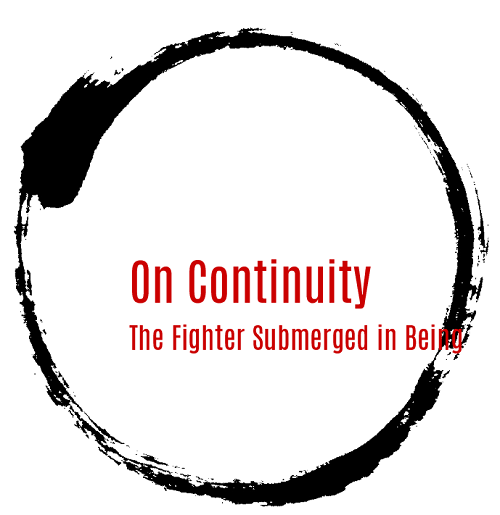
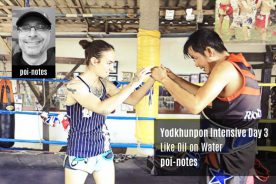



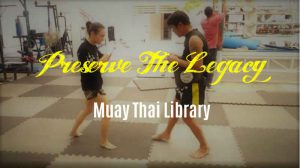
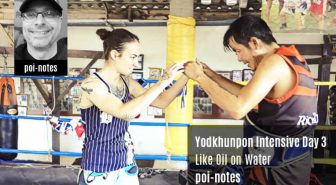
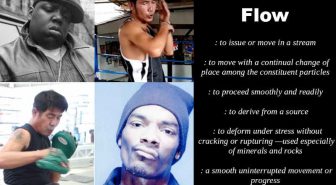
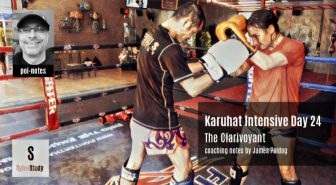
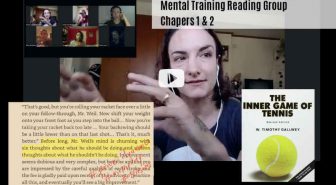
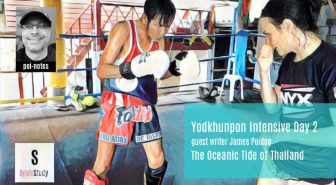
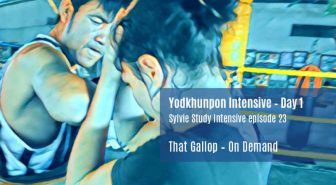
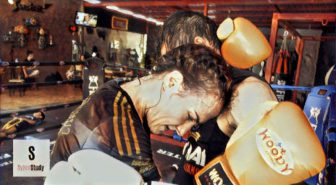
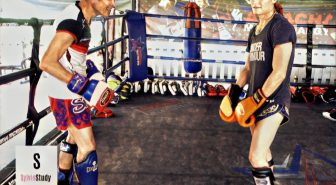

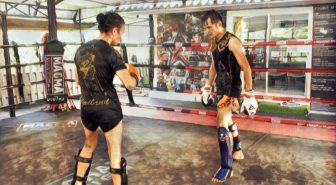
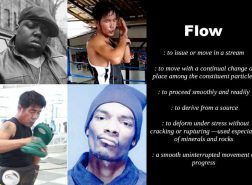
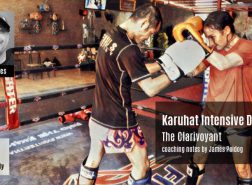
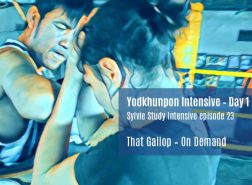
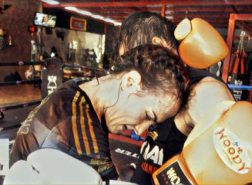
Damn, Kevin. Two good writers and philosophers in the family!
Hey thanks for that. It was literature that brought us together, the poet Holderlin and then the writer von Kleist, so in many ways words and ideas were in the original bond, from love at first sight.